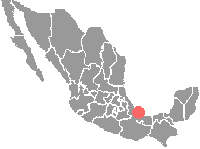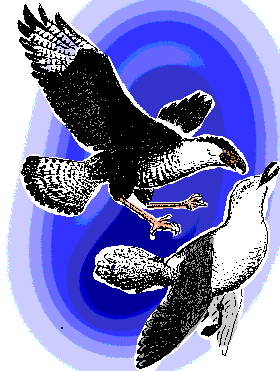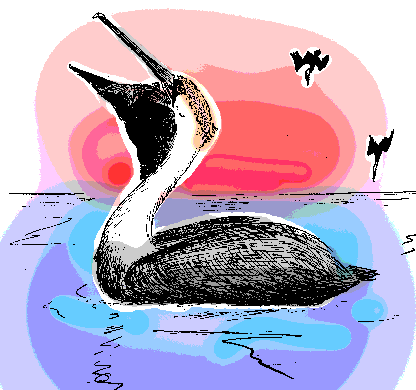 On
my third morning beside the lake I hop into the back of another pickup-truck taxi, ride
back into town and buy provisions. In the marketplace an old woman from whom I'm buying
three tamales asks me to go with her to a place where others can't hear. Nervously combing
her hair she tells me she recognizes me as a brujo, a "witchdoctor."
But I'm a good one, she says, one who's "clean inside." She wants me to go with
her to meet another brujo.
On
my third morning beside the lake I hop into the back of another pickup-truck taxi, ride
back into town and buy provisions. In the marketplace an old woman from whom I'm buying
three tamales asks me to go with her to a place where others can't hear. Nervously combing
her hair she tells me she recognizes me as a brujo, a "witchdoctor."
But I'm a good one, she says, one who's "clean inside." She wants me to go with
her to meet another brujo.
I don't know what this is all about, don't like the feeling of it, and tell her I'm not interested. I fill my backpack with food and water, hike to the edge of town, and climb into the back of another pickup truck heading for the seaside settlement of Montepio.
After 15 or 20 kilometers the rough gravel road ends at a small but handsome church with the blue Gulf of Mexico as its backdrop. In mid afternoon the heat is staggering so I walk directly onto the sandy beach where a light breeze stirs and foot-tall waves curl and collapse at the water's edge.
To the right the beach soon ends at a nearly vertical, black, basalt-rock cliff partly overgrown with cacti, aroids, and other big-leafed tropical plants. To the left the beach is bisected by a stream maybe forty feet across. My first impulse is that there's no place here for a tent, that I'll have to walk through the heat and glaring sunlight inland and find a campsite in an abandoned plantation or among the weeds -- not a pleasant thought.
But then on the left a boy on a horse approaches a certain spot at the river's edge, the horse plunges in, and walks across, the horse's belly getting only slightly wet. I go there and cross, too, though the current is strong and I must raise the backpack with my arms to keep it from getting wet.
Across the river and around the bend I can see that the beach continues to the north until an upland juts into the sea seven or so kilometers to the northwest. Just inland from the sand something like a high levee, some kind of sand dune, rises up like a wall paralleling the beach.
Two or three kilometers northwest of Montepio along the beach I feel alone, just me, the sea, the sand, and the dune-levee. In one place at the base of the levee there's a dense thicket of small trees so I work into their shadows and peg the tent there. From the sun-bathed beach it looks so dark among the trees that the tent simply can't be seen, but from the tent I can see everything on the beach. It's about as good as you get in terms of security-minded beach-camping.
PLOVER MEDITATION
I love beachwalking, especially with binoculars so I can identify the birds. Nearly any sandy beach has its little or big clusters of small or large birds most of the day working along the water's edge. Inland birds typically are very active just after dawn and then again a bit less active just before dusk, but during most of the day they are relatively quiet. Beach birds are always doing something worth looking at, from dawn to dusk. Also, always there's the knowledge that this very water beside you connects directly to the farthermost points of the Earth, so always there's a chance of meeting something completely unexpected, possibly a real treasure. This kind of beach-discovering is a meditation for me.
On my first beach walk I spot a medium-size, moderately long-legged bird with a slender but relatively short beak, probably some kind of plover. However its plumage is splotchy and unlike anything illustrated in my field guides.
This little mystery is exactly the kind of bird-puzzle that pleases me. From a distance with my binoculars I absorb as much as I can of its size, shape, color and behavior, then thumb through the field guide seeing what the possibilities are for this part of Mexico during this time of year, and there are several. I suspect it's a Black-bellied Plover with a plumage changing from its striking summer costume to its duller winter one. However, this bird isn't showing the fieldmarks needed for a solid identification.
Once my mind is clear on which identities are possible, and which fieldmarks characterize each species, with my binoculars raised ready to be looked through in an instant, I purposefully walk toward the mystery bird. It flies up, the binoculars are in place, and I see very clearly a white rump and black patches beneath the wing. It is indeed the Black-bellied Plover, a bird I seldom see.
One reason I seldom see it is that it nests only in the arctic tundra, and winters only along the coasts, and I just miss it during migrations.
I'd like to see this bird in its full summer plumage. Most multi-hued birds are dark above and pale below -- a scheme known as countershading. Countershading helps camouflage a bird. During the summer, Black-bellied Plovers are black below and much paler above -- examples of "reverse countershading," which makes them more visible. Black-bellied Plovers and Bobolinks are among the best examples of reverse countershading, and I just wonder what adaptive pressure encouraged these species to evolve in a direction opposite to most other birds.
SEVEN VULTURES AND AN EEL
Right in front of my tent, just this side of the breaking waves, there's a dead eel or eel-like fish. A Black Vulture comes winging down beach, spots the feast, and lands. The bird tugs at the fish's head causing the dead animal's silvery tail to flip as if it's alive. This obviously surprises the vulture, who jumps straight up like a cartoon character.
Before the bird's nerves can be calmed a second vulture drops from the sky and tries to join in the eating. However, the first vulture seems in no mood for sharing, for it makes a tentative lunge at its visitor, and that's enough to keep the meal to itself. The visitor continues to lounge five feet away looking hungry.
A third Black Vulture arrives, but it also meets resistance, and ends up lolling on the sand with the second bird.
But then a fourth Black Vulture lands, and instantly I see that the first bird loses its confidence. Obviously Number Four is higher ranked, for after half a second of half-hearted pecking, Number One moves away, leaving the eel to its new owner. Now Number One joins Numbers Two and Three standing on the sand.
Then Numbers Five and Six arrive, but Number Four holds its own, and they join One, Two, and Three, watching Four eat.
Five minutes pass and then Number Seven arrives and without hesitation attacks Number Four. Seven and Four must be mortal enemies, for it's not enough for Seven to chase Four from its prize; Seven's attack is so brisk that Four begins hopping down the beach, flapping frantically, struggling to get into the sky, and Seven goes hopping and flapping after him. They manage to lift off at about the same time and in the sky their chase continues, leaving a new squabble among the five vultures left behind.
Now all the birds divide their pecks among their neighbors and the eel. The eel gets covered with sand and almost lost in the confusion. But then one of the two vultures who just left returns, presumably Number Seven, and order is restored when all the other birds give way and resume standing awkwardly on the sand.
Finally all the onlookers give up and fly away, leaving only one onlooker and the eater. A few pecks are exchanged in what must represent an hierarchical challenge but the challenger doesn't have the mettle to dislodge the eater from its meal, and then it also flies away.
Now there's one vulture and one dead eel, and after a very great deal of commotion at last this one bird eats in peace.
SANDERLING/ CRAB MYSTERY
About two hours after the above vulture-and-eel drama, up the beach come seven Sanderlings. A wave withdraws and the Sanderlings chase it, stabbing into the sand with their slender, medium-length, black beaks, and then the next wave chases them back onto higher sand, sometimes causing one to flash a wing-flap or two to get out of the water's way. Then the Sanderlings chase the next wave out; this, again and again.
When the little flock reaches the exact spot where the vulture-and-eel drama took place, though by now waves have obliterated all traces I can see of the event, all seven Sanderlings begin walking about, probing the wet sand with their beaks. The probing is so intense and methodical that the bills remind me of sewing-machine needles stabbing in and out of fabric.
After the vulture-and-eel spot has been thoroughly roughed up by all the beak-probing, across the hot, dry sand upslope of the action comes a large, grayish-brown crab with conspicuously black, stalked eyes. The crab goes right into the center of the Sanderling flock and while it makes no effort to snap at the birds with its claw it does stop them from foraging. As the Sanderlings stand around looking at the big crab parked exactly where they want to be, along comes another small crab, and then a very small crab, and at this point the Sanderlings give up their efforts and begin drifting on up the beach, leaving the three crabs in possession of the spot where, to my eyes, all vestiges of food disappeared hours ago.
SUDDEN UNEXPECTED
 The hours
pass with little sense of there ever being anything other than "now." An
immature Laughing
Gull drifts by just offshore and it hardly registers more than one's turning
in bed during a sound sleep.
The hours
pass with little sense of there ever being anything other than "now." An
immature Laughing
Gull drifts by just offshore and it hardly registers more than one's turning
in bed during a sound sleep.
But then like a flash of lightning from over the dune-levee behind me a Crested Caracara bolts across the sky right above me and for an instant I see the moment exactly as I sketched at the right.
There is no kill, not even a certain touching of the two birds, and within seconds the caracara is back across the dune-levee and the gull is on down the beach.
I hadn't expected to see a caracara here, and, once I think about it, this is the first gull I've seen since I've been here. What an amazing, unforeseen moment!
And then, the rest of the day, it's more sweet monotony.
